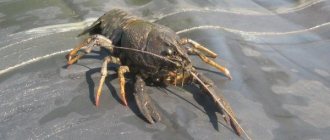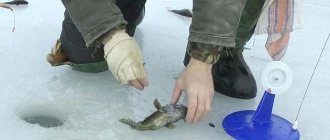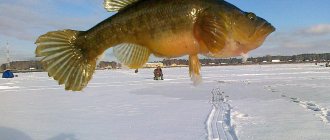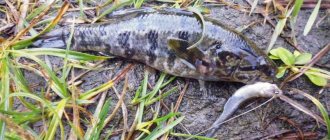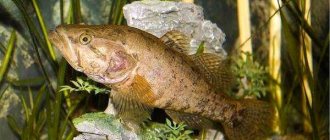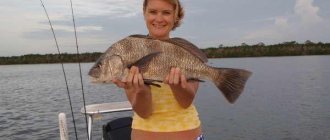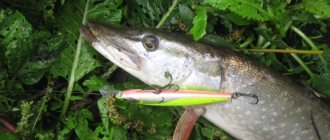Peculiarities of rotan behavior
Rotan continues to spread from year to year, and its unpretentiousness to the habitat contributes to reproduction in conditions unsuitable for other fish. It follows that first of all, you need to make sure that rotan is present in a particular body of water.
The larger the lake or pond, the greater the likelihood of catching a trophy specimen. With a sufficient amount of food and small peaceful fish, which are potential prey for predators, rotan fish can gain weight of more than 0.5 kg with a height of over 35 cm. If there is no pike in the reservoir, then rotan, eating eggs and juveniles of peaceful fish, reduces their population.
Peculiarities of rotan biting in October
I live in a large city next to a small body of water. The other day I learned from a local fisherman that rotan lives there. I had never encountered this fish before. Tell me, does it bite in the fall and what should I use to catch it?
Rotan is found in many inland waters. Outwardly, it resembles a goby, but differs in paired fins on its belly, near its head. This is a predator whose main diet consists of fry, crustaceans, amphipods and other small inhabitants of water bodies. In the fall, it is more advisable to catch it with a jig. Active play forces small predators to attack the bait. Bloodworms or small maggots, pieces of worms are used as bait. If you don’t have the necessary bait at hand, you can get it directly from the pond. Any piece of meat, be it a larva or a small fish, will perfectly replace a worm.
The equipment is as follows: an inertial reel is installed on the fly rod, the diameter of the fishing line should not exceed 0.12-0.14 mm. In place of the tulip of the fly rod, a side nod is attached, through which the fishing line is passed. The “guard” should have a bright color and be noticeable, since the bite occurs at a considerable distance. Tungsten jigs have a significant advantage over their lead counterparts. Its shape depends on the preferences of the angler. The most popular are “drops”, “balls”, “Ural”, “ants” and “nymphs”. Rotan is a bottom species, so it makes no sense to use a tandem of jigs.
This fish is a schooling fish, so it makes sense to use bait that will keep rotans in the fishing zone. The chopped worm is mixed with sifted soil, and the resulting mixture is rolled into balls. “Dry blood” and meat attractants are also added, which increase the effectiveness of feeding and stimulate appetite. You can diversify the mixture with the dry component - breadcrumbs have a wonderful aroma and attract fish. Even if rotan is not tempted by such a trick, crackers will attract fry - the basis of the food supply of this species. Feeding should be done every half hour or when the intensity of the bite decreases.
To learn more:
How to choose a bull fishing rod?
Rotan in October and November is caught no worse than in the summer. Its numbers and gluttony ensure a good catch. The only downside is the size of the fish. Specimens over 200 g are rarely caught, and the bulk of the catch is made up of 30-70 gram “trophies”. A fishing spot should be chosen with a large number of fry, but finding them in the fall is problematic. The advantage of fishing with a jig is the quick search for small predators. It’s not worth staying at one point, 5-10 transactions and the transition.
Rotan in spring
After the ice begins to melt, rotan in the spring continues to remain in the “wintering” areas until the freeze-up completely disappears. These are depressions overgrown with algae and places with abundant dying vegetation. At the beginning of spring, increased activity is observed only in small rotan. On sunny days, flocks can be found throughout the ice-free water area of the reservoir.
As the water warms up, small fish and water insects “wakes up”. The largest rotans living in a particular body of water begin to move behind them. In the second half of spring, the predator is found everywhere. Before spawning, sexually mature large predators begin to eat. During this period, he reacts to everything that reminds him of his usual prey.
Rotan in summer
At the beginning of summer, rotan spawns. It can last until the second half of June, and during this period, targeted fishing for rotan by amateur fishermen is usually not practiced.
After spawning, the predator is highly active during daylight hours. Experience shows that the best bite is observed at dawn and sunset. But this is not dogma. It is known that even in the sunshine you can expect a rotan bite.
Baits and baits
Rotan is a predator, but with pleasure it attacks everything that moves, not only edible things, but also artificial baits.
Animal bait
- worm;
- bloodworm;
- maggot;
- various insects;
- meat (anyone's).
Plant attachments
- various cereals;
- corn;
- peas.
Artificial baits:
- twisters;
- artificial bloodworm;
- artificial maggot;
- rubber worms.
Secrets to Successful Float Fishing - 17 Tips to Improve Your Float Fishing.
The Ultimate Guide to Float Fishing.
How to choose the right float rod - read the guide.
Tackle for rotan
For each fishing method, appropriate gear for rotan is prepared: • Float rod. Excellent for shore and boat fishing. The 2.7 m long Bolognese fishing rod is highly practical. The inertia-free reel ensures casting to the required distance. You can equip a float rod for any fishing conditions: for wiring, for fishing with live bait, etc.; • Spinning. This is a universal tackle for catching all predatory fish. The main thing is to choose the right rod for spinning and install the appropriate equipment. Fishing for rotan is fraught with frequent snags on bottom obstacles and algae, so it is important to choose the right cord for the spinning rod; • Tackle elastic band. This catchy tackle is excellent for catching rotan in reservoirs with standing water or slight current; • Summer girders. With the help of summer girders you can diversify fishing for trophy rotan in the coastal zone. Steep banks turning into landfalls are excellent signs for casting live bait gear; • Tackle for vertical trolling. A winter fishing rod with a nod is used when fishing for rotan from a boat.
Catching rotan: teapot tips for beginners
Several years ago, in a fishing periodical, I came across an article about catching rotan with a spinning rod. The first reaction was predictable - a bewildered shrug of the shoulders: apparently things are really bad with fish among Muscovites, if they have come to such a life as to catch rotan with a spinning rod. Could I have thought then that “this cup would not pass away from me?”
It is extremely rare for an event to happen spontaneously, out of the blue; there is always a chain of some factors that precede it. The first such factor for me was the transition to “light weight” spin fishing. Then, and incidentally, during a completely different search, on the OnlySpin Youtube channel, for the first time, a video about catching rotan with a drop shot and weki was watched from start to finish youtube.com/watch. It didn’t evoke any response then either: well, the guys catch rotan using exotic methods and let them catch it - it happens...
And then there was an extremely unfavorable weather conditions for fishing with light jigs at the end of September - beginning of October. It was not blowing like a joke and there was no question about a foray onto the Neva. In addition, I had completely chosen my monthly limit of funds, which I allocate to myself for fishing, my wife got sick, and only then did I remember that there is a park across the road, and in it there are swamps (officially ponds) with rotans. Well, if the card fell like that, then purkua wouldn’t be a problem.
Perhaps it was the stars that were so aligned (however, you can see a sign of fate after the fact in anything), but on the eve of Day “H” a report appeared on the portal about a campaign against rotan Mikhail (esox) fish-hook.ru/po…dil-1920/ (Allerdings69) https://fish-hook.ru/ar...ok-2365/ .
I took my standard (don’t think anything good about it - at that time it was the only one in this weight category) world-light-jigging set with me to the pond: spinning rod MC Solpara SPS-T762M (229cm/0.5-7 g), Daiwa reel Revros MX2004, with Yamotoya Sheller Resin PE #0.4 cord. Since the wind, gear and depths of the ponds did not allow me to use a purely microjig (fishing with unloaded rubber was not even considered as an option), I decided to rely on lead rigs: a non-classical split shot and Carolina. I started with the furthest one from the house and the road and, according to the memories of four years ago (I once tested homemade jerks in this pond in late autumn, and in the summer I constantly saw float fishermen here), the deepest pond and Carolina with a load of 3 grams of olive. Alas, nothing was caught except grass, there weren’t even any bites. The same thing happened on the second pond, and on the third, and on the fourth... And then I got tired of it and decided to use a drop-shot with a weight (homemade Cheburashka) 3.9 g and... the process got off the ground - I felt the first bite. After the third bite, I felt that the rotan was not a perch and there was no need to rush to hook it. A very thoughtful conclusion, especially considering that as a child, when fishing from ice, I saw exactly how rotan takes bait. Be that as it may, but on some kind of retrieve, after a long and leisurely chewing of the slug (I was fishing at that moment on a CF Cruel Leach 2 inch), I caught my first rattan. The only shame is that such a significant event was honored with a photo shoot using improvised means - the batteries in the digital camera ran out, and the case with spare ones naturally remained at home. I had to shoot with an old Nokia 6300. I changed the bait to a CF Tipsy in the hope that a slightly smaller bait size would give a slightly larger realization. I made a mistake. Happens. Nevertheless, I still caught the second rotan. Although it pecked on each trip, and more than once. After several fishing trips here, I can say that this is a unique feature of this pond: a lot of small, ever-hungry rotan. By and large, the weight for the equipment could have been used less, up to 3 grams. If it weren't for the wind.
If you think that this fishing was followed by an in-depth analysis of what happened, the study of some materials available on the Internet about rotan fishing, then you are completely in vain to think so. This all finally happened, but alas, in the process of working on this material, And at that time, the first fishing experience was considered nothing more than a substitute for the usual fishing on the Neva, a forced and temporary measure. How something temporary relates to practice was discussed not so long ago and therefore I will not repeat it. The first experience was followed by a second and a third. All of them followed the same scenario: windy weather made the lower light jig on the river, if not hopeless, then certainly an unpredictable activity, and a trip to the park for rotan. Even the fishing method did not change (that’s how I caught all these drop-shot forays) only the spinning rods were changed according to the weight of the load, which in turn depended on the strength of the wind. The second exit was with Salmo Elite Microtech Jig {200 cm / 2-10 g) with a load of 6.7 g used fish-hook.ru/po...os/40303/ and again Solpara but now the equipment was 5.5 g. https:// www.fish-hook.ru/polzovateli/1970/photos/40409/ Well, I finally looked online at some animation options for the primaki, and then quite by accident.
A few words about the equipment itself. Having first become acquainted with it three years ago, I came to the conclusion that for home harvesting the best option is the classic one, in which the hook is tied to a fishing line or fluor in this way:
A simpler method of tying a hook using a Palomar knot, in my opinion, is mainly suitable for tying a rig directly while fishing - the knot turns out to be less strong. Since the “bedding horizon” of the fish (this applies not only to rotan) is unknown in advance, we do not tie the sinker, leaving an overhang of half a meter, and when fishing we select the distance from the load to the hook, securing the load with a knotless fastener.
A little about fishing rods and lures. From my point of view, the optimal action for animating a bait on a DS rig is medium-fast, or, alternatively, a stick with a solid tip. The bait for rotan and standing water can be absolutely anything. I fished with whole vibrating tails, Cruel Leach, Tipsy, Aji Meat slugs, Troutino M tadpole, and silicone scraps from larger baits. The main requirements for the bait are its plasticity, resistance to the sandpaper of rotan teeth and, preferably, “edibility” - rotan extremely rarely grabs the bait on the move with this equipment. Much more often he chews “thoughtfully”
In general, on these two fishing trips, rotans were caught regularly, of different sizes: from microbes the size of a little finger, to “trophy” specimens for a given puddle. At the end of the third fishing trip, we managed to catch small rotans on every cast. By the way, I have not yet managed to catch a larger rotan than in the photo.
Size slightly larger than average
Local trophy
Microbe
Standard size
The fish were caught, but at the same time the suspicion grew stronger that catching rotan in a more sporting way - for example, with a microjig or a weckie - would not be such an easy task and fishing would then be little different from usual.
Then in my fishing “wardrobe” there was a stick with dough up to 4 grams and I decided to try “mikrushnik”, which is what I devoted part of the fourth fishing trip to. Indeed, everything turned out to be not so simple: if perches on the Neva were regularly caught with a 3-gram Cheburashka, then for rotan in this pond even one and a half turned out to be too much. I had to reduce the weight of the load to 1 gram. In addition, for a long time I could not find the necessary wiring: standard single and double casts, wiring in the “Russian style” (two turns - pause), wiring with a rod with a “shaking” did not give any results. The result was brought by wiring when, during the fall phase, vibrations of the rod tip in a vertical or horizontal plane followed (I got a bite both ways).
The first rotan caught on a microjig
Cheburashka 1 gr
So far the largest rotan caught with a microjig
After this fishing, I decided to consult with the master - K. Kuzmin, on the forum of his website.
Me: Konstantin Evgenievich, you didn’t notice in which phase of the retrieve the rotan takes more often: on the fall of the bait or on the rise. I did catch my first rotans with a microjig (a collapsible Cheburashka 1.0 g + a Decoy Worm 19 size #10 offset jig - it looks like a large jig), but the rotans only pecked on the fall with animation (when - small movements of the tip of the spinning rod in the horizontal plane, when - light "vibration" in vertical). KK: Despite the apparent simplicity of catching rotan, you have to adapt to it every time. Including wiring the bait. If it's a micro-jig, then yes - more often on the fall with movement. Drop shot - in different ways, but still more often - when the load is on the bottom and lightly rocking with slow dragging and stopping. But in general, the best thing is veki. The wiring is clearly visible in the video.
Here is the video mentioned: youtube.com/watch
I tried to devote some of my time to this type of fishing on my fifth fishing trip. But obviously he did everything wrong: due to the lack of specific weights for veki (“cloves”), he tried to use a rather large but light little fish (0.35 g), light-accumulating, as a weighting agent, for catching smelt. A 0.07 mm cord in a wind of 4-6 m/s did not allow wiring - the bait was blown by the wind, and even due to the windage of the cord, it rose to the surface under the influence of the wind. After practicing for about 40 minutes, I closed this shop until it was clarified, so to speak. And, apparently, the development of this type of fishing - with veki - will continue in the next season. These are the impressions and thoughts
Cargo for the veka
"Strong but light"?
Thanks to those who made it through this multi-letter puzzle to the end. And giant rotans or other significant trophies to everyone!
